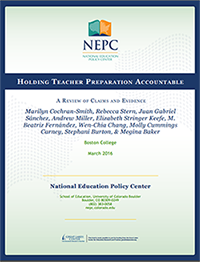Study: Evidence ‘Thin’ for Key Accountability Efforts—Except for edTPA
 A new policy brief out of the National Education Policy Center (NEPC) reviews the evidentiary base underlying four national initiatives for teacher preparation program accountability and finds that only one of them—the beginning-teacher performance assessment edTPA—is founded on claims supported by research. The other three mechanisms included in the study are the state and institutional reporting requirements under the Higher Education Act (HEA), the Council for the Accreditation of Educator Preparation (CAEP) standards and system, and the National Council on Teacher Quality (NCTQ) Teacher Prep Review.
A new policy brief out of the National Education Policy Center (NEPC) reviews the evidentiary base underlying four national initiatives for teacher preparation program accountability and finds that only one of them—the beginning-teacher performance assessment edTPA—is founded on claims supported by research. The other three mechanisms included in the study are the state and institutional reporting requirements under the Higher Education Act (HEA), the Council for the Accreditation of Educator Preparation (CAEP) standards and system, and the National Council on Teacher Quality (NCTQ) Teacher Prep Review.
Holding Teacher Preparation Accountable: A Review of Claims and Evidence, conducted by Marilyn Cochran-Smith and colleagues at Boston College (MA), investigated two primary questions: What claims does each initiative make about how it contributes to the preparation of high-quality teachers? And is there evidence that supports these claims? In addition, researchers looked at the initiatives’ potential to meet their shared goal of reducing educational inequity.
The HEA regulations, CAEP system, NCTQ review, and edTPA differ considerably in approach and administration, the study authors note, but their proponents share common assumptions about the utility of accountability mechanisms such as assessments and ratings to improve teacher preparation.
The researchers conclude that the HEA regulations, CAEP standards, and NCTQ review are supported by only “thin evidence.” Although the brief cautions that the widespread implementation of edTPA faces significant challenges, authors say its evidentiary base is stronger than that of the other initiatives.
“These findings [regarding edTPA] are very encouraging,” said AACTE President/CEO Sharon P. Robinson. “They certainly indicate that, to date, the wisdom of the profession has created the most viable tool for innovation in teacher education.”
All four initiatives promote access to high-quality teachers as a solution to the nation’s achievement gaps, but the authors say the mechanisms can provide “thin equity” at best. They say the assumption that school factors are responsible for the gaps ignores the larger effect on variances in student learning of long-standing social inequalities outside of the education system. The brief provides recommendations for policy makers to use in promoting a more equitable system and in evaluating teacher preparation quality.
For more information, visit the NEPC web site.
Tags: accreditation, assessment, equity, federal issues, program evaluation, research, student achievement, teacher quality






